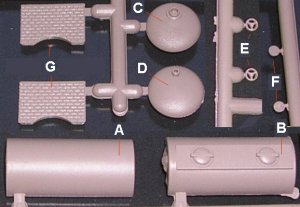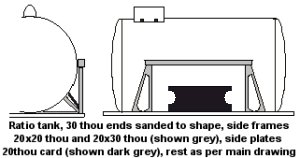| Ratio Oil Tank Kit Parts The kit comprises parts for two tanks, each tank has a smooth lower half (A), an upper half with two filler caps (B), one end with a small 'valve' (C) and one with a larger port (D). Other useful bits are the small hand wheels (E) and the blanking plates with a ring of bolts mounted on them (F). Of possible use are the 'brick' tank supports (G), which can be cut down to represent cradles in some applications. There is also some 'pipework' which can be cut about for details.  The central tube is 25mm long, the Ratio ends add about 1.5mm to each end, so the overall length is close to 28mm. The diameter is about 12mm. This is 1mm to large a diameter for demountable tanks, 11mm diameter would be a more common size for this kind of tank, but with so many batches produced you can get away with the Ratio offering and a bit of judicious filing to the base reduces the height a bit. To use the tank ends in many cases you will need to trim away the moulded ports, however this can be done (with care), the smaller port can be trimmed away with a scalpel. The larger port is actually useful as a lot of demountable tanks had a manhole access in the lower part of the lower end (the end opposite the filling dome), presumably for cleaning. |
Beer tank liveries I have not traced very much hard information on Beer tank liveries, details will be added if and when I find any. Truman, Hanbury and Buxton had tanks in brown with (I believe) white markings). Red seems to have been a common choice for the base livery, I believe McEwans used a basic dark red base colour on their demountable tanks (Scottish and Newcastle breweries operated a couple of for wheeled rail tank wagons, the body was a dark red with white serif markings). Bass had some demountable tank wagons in their all-over red Bass Charringtons company livery, these later changed to plain red with two fast traffic stars. The early Bass livery is taken from Dave Larkin's book 'Wagons of the Early British Railways Era' (well worth getting hold of). I think the tanks used for adhesives in the 1960s were bauxite (but I could be wrong on that). Some tanks carried the two star fast traffic markings, many did not and even when they did these were also on the chassis.  The chassis was fully fitted and in standard railway company livery of all-over black (as there was no body there was nowhere to apply bauxite in the BR era). All the demountable tanks seem to have had the two fast traffic star marking.  |
|
BR (ordered by LMS) 1949 wagon with two tanks for Loch Katrine water, only one built, chassis black but livery of tanks uncertain. Model uses Peco 10 foot wheelbase chassis and Ratio oil tanks kit, these are 1mm too large in diameter and the prototype had no walkway on the tank top, but it is the easiest to build I could find.  A more accurate model can be produced by trimming off the tank filler caps (try and preserve these for re-use), turning the tanks over and adding new filler domes either fro those cut off the kit or from gimp pins (glued in hole drilled in tank top) set in a dab of Milliput. There was also an earlier wagon with only a single large tank, the tank was painted in cream upper sides with chocolate lower sides (one of the managers at the works was a GWR modeller) and a single filler dome offset to one end, however the lettering on that one was much more complicated, this two-tank lettering can be printed on a computer and glued on (or even printed on a sheet of computer labels). |
BR 'demountable' beer tanks introduced in about 1949. Made using Ratio oil tanks kit and a Peco 10 foot chassis. Not exactly accurate (the tank diameter is 1mm too large) but reasonable. See also the LMS Loch Katrine water tanks for notes on making a two-half-tank type. Note the two tank type require twice as much work and they were rare. McEwans had two used between Edinburgh and Glasgow, Lemon Heart had one (carrying Loch Katrine water I believe) and Truman had one which could carry either one or two of the smaller 720 gallon tanks. My model is the McEwans/Truman's type but in fictitious livery. The beer tanks carried the brewery liveries, Bass being the most simple to letter. Some of the single tank type were later used for transporting glue to a chipboard factory in the 1970s. The sketch shows a solid base plate, my models in the photos have 10 thou strips 2mm wide across the base with the side pieces joined to these. This does not show and was more trouble than it was worth.  Some of the Bass single tanks had almost flat ends, different side braces and angled plates between the verticals connecting the tank to the base. Hence from one Ratio kit you can make a twin-tank (using all four of the Ratio ends) and a single tank as shown below.  |

